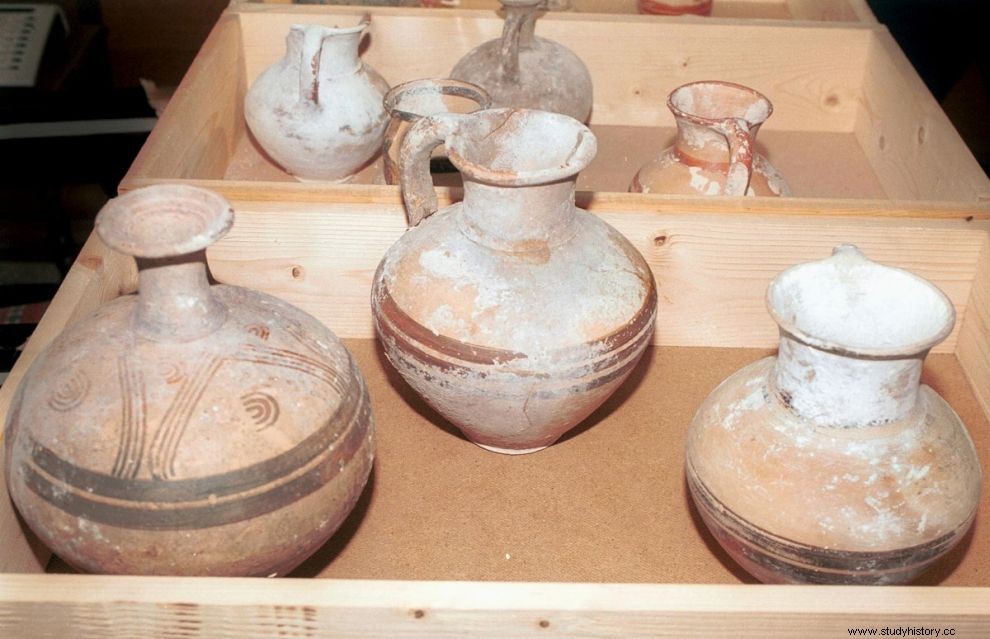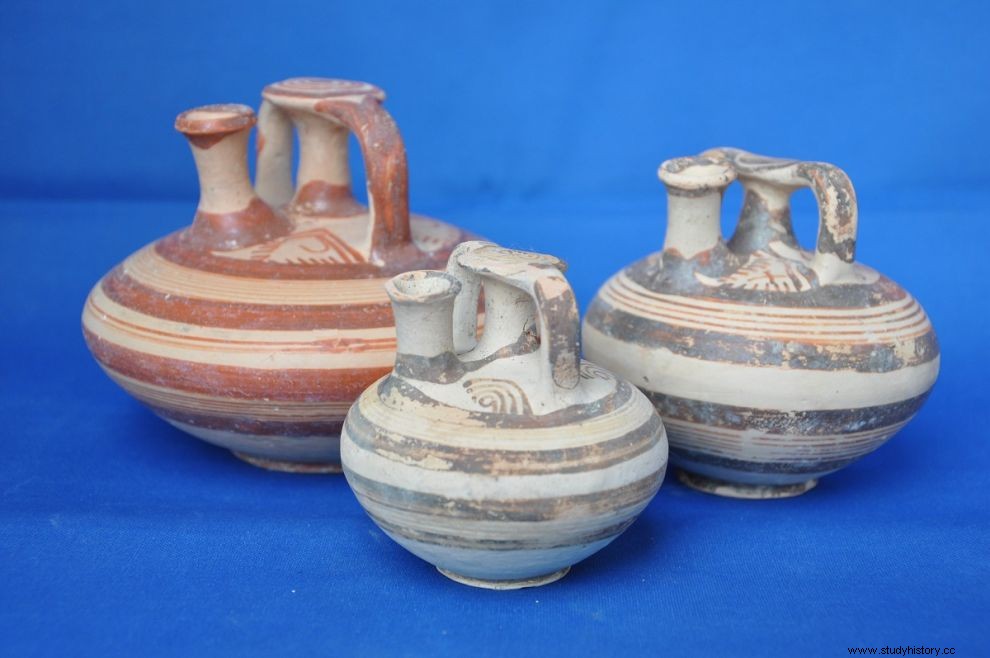Many of the ancient ceramic trinkets discovered in the graves of children who lived thousands of years ago could easily be used even today. Some of them have small decorative legs, tails, a generally playful appearance, which although they come to us from the age of bronze and iron, it seems that they were made with love for the little ones of the time.
But most importantly, like many other everyday items used for feeding and food preparation, they now offer scientists an unprecedented insight into how people ate in ancient times.
For example, an examination of fatty molecules called "lipids" and that had penetrated into the pores of three ceramic bottles from Bavaria show that mothers living between 1200 BC-450 BC. they weaned or supplemented their children's diets with animal milk, according to Julian Dunne, a biomolecular archaeologist at the University of Bristol in England.
"There aren't many ways to study infant nutrition in antiquity," she says. Ancient bones have provided information about when infants were weaned, but "we know very little about how mothers raised their babies." The same generally applies to the nutritional life of the ancients - much of which we have learned so far in an indirect way.

The newest scientific techniques , which add a more comprehensive view of the importance of everyday activities in archaeology, lead to a clearer picture of what was on the prehistoric menu. Microbes and molecular debris, gathered from bottles, fragments of pottery, and even remains from Bronze Age burial sites, offer a number of new clues about ancient cuisine.
Archaeology has until recently snubbed women
"Archaeology did exactly what everything else did," says Dunne. "Findings around women's lives tend to be left on the sidelines". And indeed come to think of it, traditionally, scholars were far more excited by the lives of kings and conquering warriors than by mothers.
"This is one reason why the 'boring' archaeological objects related to the kitchen and cooking have been somewhat neglected," writes anthropological archaeologist Sarah Graff in the Annual Review of Anthropology 2020. The objects from the "realm" of food preparation they belonged to those who had no social power:women, servants and slaves.
“Most of early archeology was about finding things that are beautiful and worthy of going into museums,” Graf says. Many times, pieces of broken vessels or ordinary-looking items from excavations were thrown aside along with what was considered useless and not examined. The older archaeologists "didn't really think that objects that had to do with household chores would have anything to do with politics or economics or even religion."
Researchers today are finding more and more of these connections, she continues, while powerful analytical techniques are helping scientists look deeply into ancient vessels to learn about the foods that were once prepared in them—from steamed foods to drinks and fermented cheeses.

Clay was the plastic of the ancient world
The game changers that made all the difference were the clay pots according to Dune. Also, ceramic pots helped a lot to change what people ate, as they could for example now boil meat for stews, or cook tubers (the edible roots) long enough for the toxins to be destroyed.
Very often archaeological sites are overwhelmed by remains of vessels. For the time, it was something like today's ubiquitous plastic. “Clay is the non-biodegradable polymer of the ancient world”, says biogeochemist Richard Eversend, Dunne's colleague at Bristol and a pioneer in the analysis of organic remains left inside ancient vessels.
Eversed and his colleagues have taken advantage of the tendency of fats to stick to pottery shards to trace what people were cooking long ago.
Boiling meat releases droplets of melted fat that easily penetrate the walls of containers, says Eversed. He made his first identification of fats, or lipids, from food in ancient pottery about 30 years ago, in medieval fragments found at a site in England. Chemical "fingerprints" revealed a cabbage leaf wax, which was probably cooked with meats..
In other work from the same site, scientists identified a large number of vessels dating from 950 to 1450 with "signatures" of dairy fat - most likely from cheese making. In some others where no fat was detected and discovered near an ancient bakery, they are believed to have been used for baking bread.
Along with analyzing the ancient remains, Eversed and his colleagues took on the challenge of disentangling environmental contamination from actual food remains. Decades ago, his team cooked cabbage leaves, for example, in order to see how his candles penetrated similar containers to those of the ancients. The researchers also marinated pieces of pottery in bottles of compost to see how microbes can change fats from milk or olive oil.

A peculiar experiment
To better understand how the cooking of the past relates to the present, other scientists have delved into this kind of experimental archaeology. Starting in 2014, the researchers cooked different recipes in store-bought ceramic pots each week. Over the course of a year, they used the same pot to cook the same recipe 50 times, then switched to a new recipe for the last meal—or the last four meals. Simple dishes included only one or two ingredients , such as corn or wheat mash or road-killed deer meat. (Apparently, no one tried them.)
The team's goal was to uncover how ancient meals can be preserved and which ingredients will be lost over time.
When the researchers finished cooking, they broke and buried the ceramic pots in the backyard of a house, with some of these fragments spending six months in the ground, others a year and others five years. The team then dug them up to see what they looked like after all those lipid mixtures.
Although the work done on lipids is "really excellent", the information you can get from them is "much more obscure than the level of resolution you can get through proteins", says Matthew Collins, an archaeologist at University of Copenhagen and Cambridge University. As with lipids, progress in analyzing ancient proteins is "absolutely technology dependent," he says. And now progress is allowing scientists to look for clues through proteins from surprising places.
Examining teeth thousands of years old
In 2014, researchers found milk proteins preserved in dental calculus that are about 5,000 years old. "It's the slab, which becomes hard," says Jessica Headey, an archaeologist at the University of York in England. Mineral material survives in skeletons and can preserve a record of some of the foods a person ate.
When archaeologists working at Çatalogyuk, a site in present-day Turkey, approached Hedi's team to ask her to examine the ceramics found there, she realized that the whitish scale covering the shards might have trapped traces of protein—exactly as occurs in teeth. From ten samples of the mineral-rich scale, the team identified a number of proteins from animals and plants. "It was an amazing resource, says Hedy, for understanding what these early farmers were growing in their pots."
The fragments yielded traces of proteins found in barley, wheat and peas, along with many animal meats and milks. While the animal bones indicated that sheep and goats lived in this ancient city, the proteins show how humans consumed them. Humans used the milk of these animals and mixed it with these other food sources, Heddy says. “That level of detail, I found really fascinating.”
Of course, any protein alone does not capture the full picture of what people once ate. In addition, some proteins survive the centuries more easily than others, further skewing the picture. It's not clear why, but milk proteins seem to keep better.
Nevertheless, proteins are a powerful source of knowledge about the dietary habits of past centuries. They are everywhere and can provide answers to some very important questions. Which tissues from an organism for example—a plant's root or its seed head—were used? How were they processed?
And the best way to achieve this understanding is to study lipids and proteins, along with other complementary sources of information, such as DNA.

The role of microbes
Researchers have been collecting lipids and proteins from ancient vessels for decades. But in the last few years, scientists have begun to look for culinary clues in the remains of a different species such as microbes, which play a key role in the creation of foods that have undergone fermentation, such as beer, wine and cheese.
Microbiologist Ronen Hazan of Jerusalem University investigated a question posed to him by a brewer friend:can yeasts stay alive in a sealed glass bottle left in the dark for two years? Yes they can.
When Hazan and his colleagues started thinking about how to brew a beer from the history books, they wondered if "ancient" yeasts could have survived to this day.
The scientists then asked the Israel Antiquities Authority for pieces of pottery that might have been used for brewing. They received pieces of clay pottery from various sites around Israel:Egyptian pottery from 3100 BC, Philistine pottery from 850 BC. and Persian from 500 BC. In total, the team isolated and grew six strains of yeast from 21 ancient vessels.
Using modern recipes, the team brewed beer using the strains they extracted. "It was good," says Aren Mayer, an archaeologist at a university in Israel. “I told everyone 'it's either going to be good or we're all going to die in half a minute'. Fortunately we survived to tell the story".
Four of the six yeasts that were extracted were able to produce alcohol and produce the aromatic compounds that make them taste good. The DNA of the yeasts revealed how they were related to other known brewing microbes. The team thought that the yeasts removed from the vessels were descendants of yeasts that were seeded thousands of years ago when beer was brewed.
Through this search for traces left behind by meals eaten centuries ago, these scientists are uncovering aspects of the common human experience of cooking. Cooking is one of the most unifying things people have across time and space. Food and its processing embody culture, politics, status, identities, upbringing and more. Although often produced without much forethought, food reveals a lot about one's place in society, but also about society itself.
